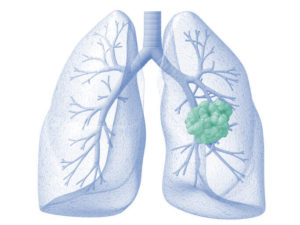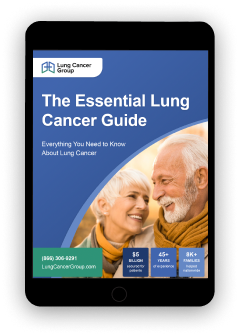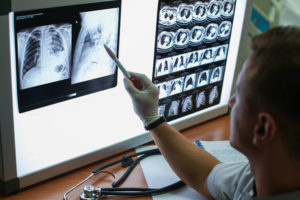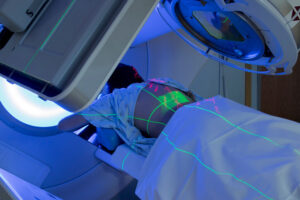Lung Carcinoids
Lung carcinoids account for the rarest type of lung cancer. They are also known as bronchial carcinoids or pulmonary carcinoid tumors. Lung carcinoids are much easier to treat than other types of lung cancer, especially when doctors diagnose a patient before the tumors spread. Below, learn how Lung Cancer Group may be able to help you secure compensation for lung carcinoids.
What Are Lung Carcinoid Tumors?
Lung carcinoids develop when neuroendocrine cells in the lungs become cancerous. Neuroendocrine cells control hormones, move blood and air through the lungs, and monitor how other cells in the lungs grow.

Bronchial carcinoids are the least common lung cancer type, making up roughly 1-2% of lung cancer cases. The Cleveland Clinic notes that between 2,000 and 4,500 people are diagnosed with lung carcinoid tumors every year in the U.S.
Lung carcinoid tumors are relatively easy to treat as they spread (metastasize) slowly, and many patients can live for years or decades after a diagnosis. However, urgent treatment is needed as bronchial carcinoids — like all other types of lung cancer — can be fatal if left unchecked.
Lung Cancer Group can help you receive compensation for treatments needed to fight lung carcinoids or any other type of lung cancer. Explore available treatments with our Free Lung Cancer Guide.

- Understand risk factors
- Find top treatments
- Pursue compensation



What Causes Lung Carcinoids?
Lung carcinoid tumors form when neuroendocrine cell DNA mutates, causing the cells to grow at out-of-control rates. The mutated cells clump together to form tumorlets that grow into neuroendocrine tumors of the lung.
Researchers are still trying to determine what causes neuroendocrine cells to become cancerous.
For example, smoking is not known to increase the risk of lung carcinoid tumors, unlike in cases of small cell lung cancer (SCLC) and non-small cell lung cancer (NSCLC), but it could still impact a patient’s health.
Smoking was linked to a lower life span in a 2023 study of patients with advanced lung carcinoid tumors published in the Annals of Oncology.
For this reason, those who smoked should still be screened for any type of lung cancer.
Risk Factors for Lung Carcinoid Tumors
Though the exact causes of lung carcinoids aren’t fully understood, researchers have identified some traits that increase the risks.
Risk factors for bronchial carcinoid tumors include:
- Age: Most people who develop lung carcinoids are between 40 and 60 years old, according to the Merck Manuals (a leading medical publication).
- Genetics: An inherited genetic condition called multiple endocrine neoplasia type 1 (MEN1) puts people at a higher risk of carcinoids. MEN1 may cause both noncancerous (benign) and cancerous neuroendocrine tumors to form.
- Race: Lung carcinoids are most common in white people, as noted by the American Cancer Society (ACS).
That said, anyone can develop lung carcinoid tumors. Medical journals have reported on cases of young adults and even children suffering from bronchial carcinoids.
Can Asbestos Exposure Cause Lung Carcinoid Tumors?
At this time, it’s not known whether or not asbestos exposure causes bronchial carcinoid tumors.
Asbestos is a fiber-like material known to cause both SCLC and NSCLC — and worsens the damage that cigarette smoke does to the lungs. It can also cause other cancers like mesothelioma.
Call (877) 446-5767 now if you were exposed to asbestos and now have a bronchial carcinoid tumor or another type of lung cancer. You may be eligible for financial compensation for medical expenses.
What Are the Symptoms of a Lung Carcinoid?
Lung carcinoids can cause many symptoms that affect a person’s breathing.
- Chest pain
- Collapsed lung
- Coughing up blood
- Difficulty breathing and shortness of breath
- Inflamed lungs
Many of the symptoms above are found in the other types of lung cancer.
That said, some patients with lung carcinoid tumors may develop a related health problem called carcinoid syndrome. This is caused when tumors release an excess of serotonin, leading to unique symptoms.
- Diarrhea
- High blood pressure
- Warmth and redness in the face
- Weakness
The Cleveland Clinic reports that more than 1 in 4 patients with lung carcinoids won’t have any symptoms. These patients are only diagnosed during tests for other conditions or routine scans.
It’s highly recommended that you see a doctor if you have any of the symptoms listed above so you can get properly diagnosed and treated.
Diagnosing Lung Carcinoids


From there, doctors may ask about the patient’s overall health history and order different tests to look for tumors inside the body.
Commonly used imaging scans include:
- Biomarker tests: These help doctors look for substances that could indicate that a patient has cancer. For example, a blood sample may be collected to look at the levels of chromogranin A, a protein secretion that may be higher in lung carcinoid patients.
- Chest X-rays: Up to 75% of all lung carcinoids are first discovered through chest X-rays, according to the U.S. National Library of Medicine.
- Computed tomography (CT) scans: CT scans can be used to find small tumors that can’t be seen on an X-ray and help determine if the cancer has spread to another spot in the body, as they are more precise.
- Other tests: Positron emission tomography (PET) scans, magnetic resonance imaging (MRI) scans, and other imaging tests might be used instead of an X-ray or CT scan.
The tests listed above can help rule out other health problems, but to confirm a lung cancer diagnosis, doctors need to take a biopsy (a sample of cancerous tissue or fluid that is removed and looked at with a microscope).
The most common type of biopsy to diagnose bronchial carcinoids is called a bronchoscopy. During a bronchoscopy, doctors lead a tiny tube down the airway to remove a sample for study.
View available treatments for bronchial carcinoid tumors and see how to afford them in our Free Lung Cancer Guide.



- Understand risk factors
- Find top treatments
- Pursue compensation



Misdiagnosing Bronchial Carcinoid Tumors
Doctors can sometimes misdiagnose lung carcinoid tumors since they are so rare and the symptoms are similar to many other health problems.
Bronchial carcinoids can be misdiagnosed as:
- Other diseases and conditions: Tuberculosis, collapsed lung, blastomycosis, and many other illnesses have similar symptoms to lung carcinoids.
- Other malignancies: Doctors may mistake lung carcinoid cells for a subtype of NSCLC called large-cell neuroendocrine carcinoma or SCLC when reviewing a biopsy.
- Noncancerous growths: Those with the MEN1 gene mutation can develop neuroendocrine neoplasms (growths) that may not be cancerous.
If you believe you’ve been misdiagnosed, get a second opinion. A different doctor will review the results of your original diagnosis and either confirm or refute them.
Types of Bronchial Carcinoid Tumors
Doctors classify carcinoid tumors of the lung into several types when making a diagnosis. The first two types are based on the tumor’s location in the body.
Types of lung carcinoids include:
- Central carcinoids: These form inside or on the bronchi (the two large airways that lead from the throat into the lungs). They look like lesions or nodules.
- Peripheral carcinoids: These develop in the bronchioles (smaller airways that split off from the bronchi) and are less common than central carcinoids.
Bronchial carcinoid tumors are also classified by how their cells grow and divide (histology).
There are two lung carcinoid cell types:
- Typical: 90% of lung carcinoids are typical. Typical carcinoid cells are slow-growing and less likely to spread past the lungs, so doctors can more effectively treat them.
- Atypical: Atypical carcinoid tumors divide at a faster rate than typical ones do, making them more aggressive and harder to treat. They’re also more likely to metastasize (spread) beyond the lungs.
Most lung carcinoid tumors will be central and typical. However, your doctor can note which type of tumor you have so you can get the most appropriate treatments.
Prognosis of Lung Carcinoids
The prognosis (health outlook) of lung carcinoids is better than many other types of lung cancer. Patients with bronchial carcinoids can live for years or decades if their cancer is promptly diagnosed and treated.
See how a lung carcinoid prognosis is measured below.
Lung Carcinoids Life Expectancy
Life expectancy is the typical length of time someone lives after a diagnosis. If they get treated, bronchial carcinoid patients have a life expectancy of 5 and a half years on average, according to a 2021 study from the medical journal Lung Cancer.
This study also found that the cancer stopped spreading for an average of 4 and a half years thanks to the treatments used.
Survival Rates for Patients With Lung Carcinoid Tumors
A survival rate is the percentage of patients still alive after a set period of time. Survival rates for those with lung carcinoid tumors are very high compared to other lung cancer types.
| Survival Rates | Typical Lung Carcinoids | Atypical Lung Carcinoids |
|---|---|---|
| 5-year survival rate | 92.4% | 56% |
| 10-year survival rate | 88.3% | 35% |
The best way for patients to live longer with bronchial carcinoids is to get treatment from experienced lung cancer doctors.
Lung Carcinoid Tumor Treatments
Doctors who specialize in oncology (cancer treatment) can use a wide range of therapies to remove and destroy carcinoid tumors. Explore top lung cancer treatment options below.
Surgery
The preferred treatment method for lung carcinoids is surgical resection (removal). A lung cancer surgery gives the patient the best chance of becoming cancer-free.
Surgeries for bronchial carcinoids include:
- Lobectomy: A lobectomy removes the carcinoid tumor and the lobe (a section of the lung) it grew on.
- Pneumonectomy: This is a more intense surgery as the entire lung and cancer tumor are removed.
- Sleeve resection: Doctors remove part of the airway that the cancer has grown into. The noncancerous ends of the airway are then reattached.
Doctors can also perform minor surgeries as a form of palliative (pain-relieving) care if the tumor can’t be fully removed.
For example, bronchoscopies may be used to remove parts of a tumor or mucus buildup to help patients breathe better, according to the Mayo Clinic.
Radiation


During radiation therapy, doctors treat lung carcinoid tumors with beams of energy. This shrinks tumors and prevents them from growing again.
Radiation can be used:
- As a main treatment if a patient can’t get surgery
- To destroy parts of a tumor that weren’t removed with surgery
- To reduce symptoms if the cancer has spread to areas like the bones
Radiation doesn’t hurt the patient but can cause side effects like nausea and hair loss, as it kills both cancer cells and healthy cells.
Chemotherapy
Chemotherapy (cancer-killing drugs) are typically used to kill cancer bronchial carcinoid cells alongside a major surgery. The Cleveland Clinic notes that chemotherapy is often recommended in cases where the cancer has spread.
This is because doctors give chemotherapy through the bloodstream, allowing the drugs to move through the body and destroy spreading cancer cells along the way.
Clinical Trials
Some patients with bronchial carcinoids may qualify to join clinical trials where new lung cancer treatments are studied.
Currently, clinical trials for bronchial carcinoids are investigating:
- The use of targeted radiation to treat patients with metastatic cancer
- Targeted therapies such as mTOR inhibitors that prevent bronchial carcinoid cells from dividing and growing
- If immunotherapy (medications that boost the immune response) could help patients with bronchial carcinoids
It may be possible to join a clinical trial depending on what type of bronchial carcinoid tumor you have, where the study is being conducted, and other factors.
Reach out to your health care team to find lung cancer clinical trials that you may be eligible for.
We Can Help Patients With Lung Carcinoids
Lung carcinoid patients deserve the best medical care available so they can live for years or even decades with this cancer. However, treatments for bronchial carcinoids can be expensive — even with insurance.
The good news is that our team can help you afford these medical costs.
Work with Lung Cancer Group to:
- Find out if you’re eligible for lung cancer compensation
- File claims to get a financial payout
- Secure justice and cover your expenses
We’ve helped many qualifying lung cancer patients access millions of dollars following a diagnosis, alleviating financial worries.
Our team is standing by to help you and your family. Get a free case review right now to learn if you qualify.
Lung Carcinoids FAQs
Are carcinoid tumors always cancerous?
Yes. All lung carcinoid tumors are malignant (cancerous), according to a 2023 report published by the U.S. National Library of Medicine. They develop when pulmonary neuroendocrine cells mutate into cancerous ones.
Not all lung tumors are cancerous, though. For example, those with the MEN1 gene are at a higher risk of both bronchial carcinoid tumors and noncancerous growths called neuroendocrine neoplasms.
Doctors can determine if a tumor or growth is cancerous by performing a biopsy.
Are lung carcinoid tumors rare?
Yes, lung carcinoid tumors are rare. Only 1-2% of lung cancer patients have this type, meaning just a few thousand people are diagnosed per year.
Even though lung carcinoids are rare, doctors can often effectively treat them — especially when patients are diagnosed before the cancer spreads.
How bad are carcinoid tumors in the lungs?
How severe a carcinoid tumor in the lungs will be depends on how fast the cancer spreads, how well your body responds to treatment, your overall health, and other factors.
It’s possible to live for decades with a bronchial carcinoid tumor. In fact, over 75% of patients with typical carcinoid tumors live for 15 years after getting surgery.
Your lung cancer care team can determine how long you can expect to live with a bronchial carcinoid tumor. Keep in mind that you may even outlive the prognosis that your health care team gives.
Can lung carcinoid tumors be cured?
Possibly, yes. There’s no official cure for any type of cancer, but it may be possible to live the rest of your life cancer-free with the right treatments.
Surgery for bronchial carcinoids offers the best chance for a patient to be cured since doctors can often entirely remove tumors.
Other treatments like chemotherapy and radiation can also be used to treat lung carcinoids and help you live longer or cure you.
Get our Free Lung Cancer Guide to understand your treatment options.

